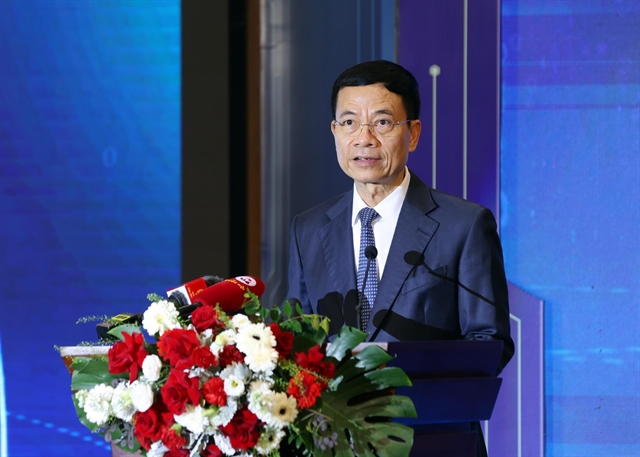 Society
Society

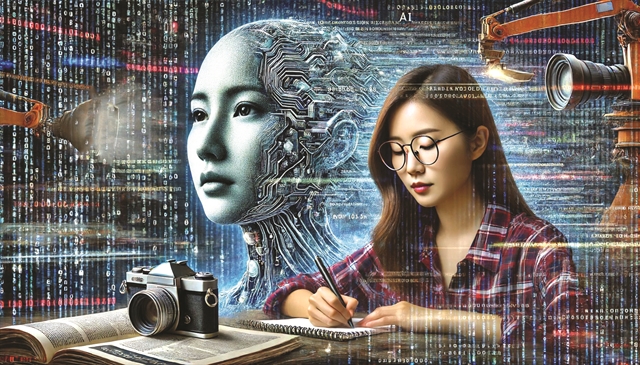 |
| CHANGING HORIZONS: With the advantages AI offers, media outlets should not miss this technological revolution. They should leverage AI to better serve their audiences. Photo created by ChatGPT |
Thu Vân
Experts in journalism and communications believe that AI should not be viewed as a threat to the profession, but rather as a valuable tool if journalism and media outlets know how to leverage it effectively.
While recognising the significant impact of AI on various industries, including media and journalism, and acknowledging its rapid development in revolutionising information creation and distribution, experts believe AI can help newsrooms better understand their readers, accurately assess their needs, and produce more practical and humane content.
Rishad Patel, co-founder of Splice Media, says he thinks the understanding of AI is significant, but rather than using AI for what it’s popularly known for, which is to generate more content, journalists and media outlets can use the technology to better serve their audiences.
"The future of journalism is user-centred, built by AI, based on user preferences and needs," Patel says.
According to Nguyễn Hoàng Nhật, deputy editor-in-chief of VietnamPlus online newspaper, thanks to AI, media agencies can filter audience segments, select keywords, proofread for spelling errors, analyse reading trends, or optimise images. Some media agencies have also used AI to produce multimedia products such as graphics, videos, and e-magazines or to analyse data for developing high-quality special reports and investigative series.
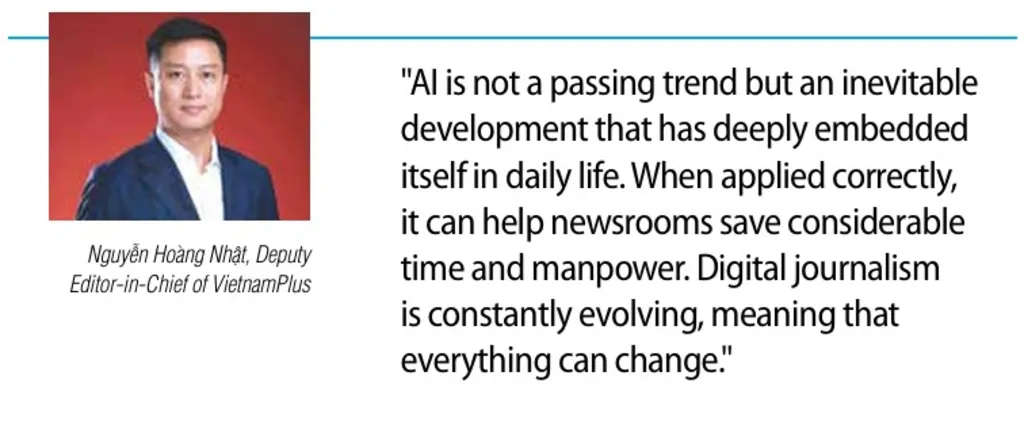 |
AI can also assist media agencies in researching brand information to execute communication strategies, thus diversifying revenue sources for journalism.
Nhật says he believes that AI is not a transient trend but has become an inevitable trend deeply embedded in daily life. If applied reasonably, it will help newsrooms save a lot of time and human resources. Digital journalism is constantly evolving, meaning everything can change. With the benefits AI brings, Vietnamese media should not miss this "train".
Trần Vũ Nguyên, chairman of the Asia Innovative Education Group, says that AI is widely used in various fields and that more AI applications in communication appear every day. There is a current trend towards using the best tools to serve work.
Nguyên says there are aspects of work that AI finds difficult to replace human beings in, such as community connection or addressing topics related to public life and civil issues, as well as elements related to emotional intelligence and humaneness. This is especially true when dealing with information that is "not available on the internet".
“Journalists, therefore, play the role of superconnectors, a function that AI can never replicate,” Nguyên adds.
Know your audience
Patel says technology is not the big disruptor for modern journalism.
“The biggest threat to the media business is failing to give people what they want, failing to ask them what they want. The media business is driven by demand, and it is based on the interest of the users. It is based on the need of the user, and it can only survive if it solves specific user problems," he says.
He thus asserts that modern media must answer five questions: Who needs this information? Why do they need it? How can they access it? What can they do with it? How do they know this information is true?
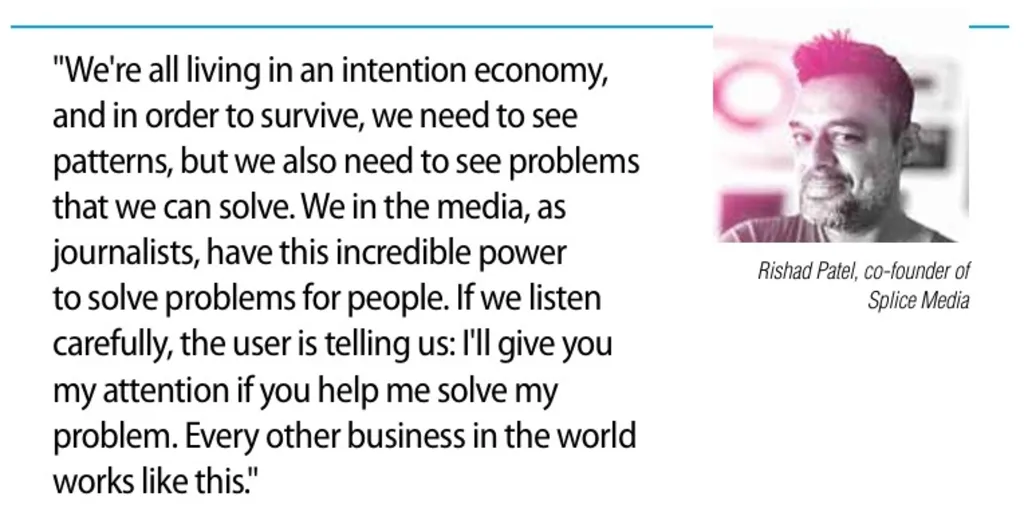 |
Citing a lesson from Pringles, which provides 50 flavours of chips to serve different needs of consumers, Patel says the job of media outlets is to provide the 'flavour' that readers need.
"Do you ask people what chips they want? What flavour do they want? And you give them those chips, and you make them better and better because none of us want the same chip," he says.
He suggests media outlets build a direct relationship with their audience using AI.
“I think it’s about taking this huge technology that is freely available to us at very low cost, and using this technology to find and solve those user needs at scale,” he says.
"I think media companies don't do enough... I think the job of every journalist, every editor, and every person who works in the newsroom should be to go and have coffee with your users at least once a week. The things you learn about your company, about your content, about your business and about your job are staggering."
Nhật says that understanding what readers wanted was challenging, but thanks to AI tools to analyse reader data, it is now possible to understand the real needs of readers and determine the necessary topics.
Nhật says that journalism used to go in the wrong direction by overemphasising hot news, leading to reader fatigue and a tendency to avoid the news. Recently, thanks to surveys using AI tools, content has become simpler and more humane, aligning with viewer preferences such as summer recipes and autumn fashion trends.
"When we conducted research on reader needs, we found that we often went in the wrong direction, focusing too much on hot news. But readers have a wide range of interests. Thanks to AI, we know exactly what readers want to read. AI is steering journalism in a more positive and humane direction," Nhật says.
"Today, the value of news is no longer measured by views or hits but by viewer interactions and emotional reactions," he adds.
The risks
AI has rapidly developed over the past two years, with the emergence of popular AI chatbots like ChatGPT, Gemini, and Copilot, as well as image and video creation applications like DALL-E and Sora. The intelligence of these chatbots and AI applications is undeniable. Users can request information retrieval, document summarisation, or even create themed images and dancing videos from a single photo with simple prompts.
However, AI chatbots also have drawbacks, such as occasional "hallucinations" and "forgetfulness". These are significant risks when using AI.
According to Đặng Hải Lộc, CEO of AIV Group, a company specialising in AI research for media, AI can sometimes produce inaccurate and self-interpreted results, known as hallucinations. He cites an example from the United States where lawyers asked an AI chatbot to summarise local cases. Upon reviewing the results, they found that two cases were fabricated by the AI.
Lộc says even Apple acknowledged it might never fully resolve the issue of AI "lying".
"We must gradually get used to the fact that when using AI, there is sometimes no 100 per cent accuracy," he says.
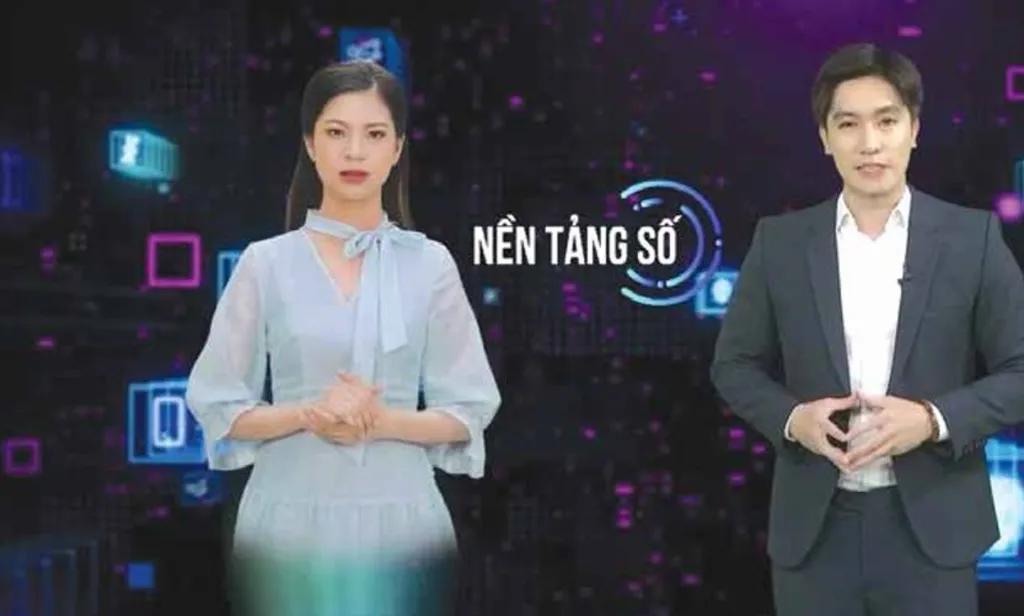 |
| AI - POWERED NEWS HOSTS: AI is set to change the nature of journalism. |
Technology experts have surveyed several specialised AI chatbots in finance and law, created from "clean" data sources. However, these chatbots were only slightly more reliable than ChatGPT and Gemini, still making mistakes. Lộc emphasises that for issues requiring deep analysis, AI could be up to 10 per cent inaccurate.
Đặng Phạm Thiên Duy, a senior lecturer at RMIT University Vietnam, says that AI also has the drawback of "forgetfulness". For example, he says, when creating a comic strip with characters acting in a linear timeline, AI cannot remember past actions of the characters.
Moreover, there are not many tools to verify the authenticity of AI-provided information, nor many tools to distinguish between human-created and AI-generated content. This raises the issue of transparency rules in journalism and media for AI-created products.
Nhật from VietnamPlus says that Việt Nam currently lacks specific legal tools for using AI. Most AI usage guidelines in Vietnamese media are borrowed from foreign journalism. Many media agencies do not even have detailed AI usage guidelines.
To mitigate the risks of using AI-provided information, Duy suggests that users double-check the information from multiple sources or use fact-checking tools from companies like Microsoft and Google. Another method is to "challenge" AI to reason, such as verifying if an event actually occurred in a particular year, to avoid misleading information.
How AI will develop
Experts agree that it is challenging to predict the trajectory of rapidly changing technology like AI. However, in 6 months to 1 year, AI could develop in three main directions, according to Lộc from AIV Group.
First, AI will be deeply integrated into smart devices. For example, ChatGPT will be incorporated into smartphones. While AI chatbots are currently optional applications, they will become ubiquitous in personal electronic devices going forward. For instance, Microsoft recently announced the integration of Copilot into Windows computers, and Apple will incorporate ChatGPT into iPhones, as announced at the WWDC event on 11 June.
Lộc notes that alongside the transformation of personal electronic devices, common software like Word and Excel will also change. AI will drive a hardware revolution, such as the development of robots with human-like expressions.
Additionally, AI will significantly influence human life, making personal data easier to collect.
"If we provide information to readers, we will have readers. If we solve readers' needs, we will have loyal readers," Lộc says.
The second development is the emergence of the next-generation chatbot, GPT-5, known as General AI. Sam Altman, CEO of OpenAI, says that if GPT-4 is considered the smartest chatbot today, with the arrival of GPT-5, GPT-4 will be seen as rudimentary. GPT-5 is expected to have the capability to read images, listen, and perceive emotions.
The third trend is the advancement in generative image and video technology. Lộc predicts that while current technology allows users to create short videos from a single image, the next year will see significant improvements. Future technology will enable users to create a fully animated video or an engaging short film.
"In one year, users will be able to describe a setting and have a 3D space created, eliminating the need for time-consuming measurements and 3D modelling," Lộc says.
"In the future, presenters will be able to request changes to the studio environment to match their desired themes." VNS




